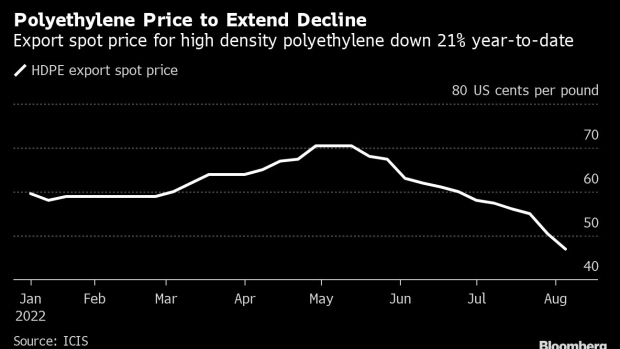Aug 11, 2022
US Plastics Prices Seen Extending Decline in US as Glut Emerges
, Bloomberg News

(Bloomberg) -- US plastics prices are likely to keep falling from their post-pandemic highs amid rising production and slowing demand, providing some good news for consumers such as auto manufacturers who have been struggling with surging raw material inflation since the height of the Covid-19 pandemic.
The contract price for high density polyethylene, or HDPE, a closely watched benchmark in the plastics industry, is set to extend declines this year, according to industry analysts, who cite weaker spot prices. Export spot prices for US HDPE are down by 12.5 cents per pound, or 21%, since the beginning of January, according to ICIS.
The downturn follows a dramatic rally that peaked in 2021 as government stimulus helped the global economy rebound from the worst effects of disruption caused by the virus. That snapback in demand for cars, electronics and other consumer goods led to unprecedented supply-chain snarl-ups, which further inflamed price inflation. On top of that, the US Gulf Coast, a major production center for petrochemicals, saw capacity curtailed by the impact of hurricanes and a severe winter storm.
But now the global economy is cooling, with worldwide growth expected to slump to 2.9 percent in 2022, from 5.7 percent in 2021, according to the World Bank.
The chemicals industry is seeing a slowdown play out across its major markets. LyondellBasell Industries NV, one of the world’s largest US plastics companies and with major Gulf Coast operations, said last month that moderating demand in China and Europe is likely to compress margins across most of the company’s businesses in the third quarter. US chemical maker Huntsman Corp. said last week that North American markets face challenges as increasing costs and rising interest rates will likely slow demand and lower consumer confidence.
See also: Oil demand in petrochemicals to double by 2050, BNEF says
For the US plastics industry, the deceleration in consumption is coming at particularly inconvenient time as it’s continuing to ramp up capacity. The multi-year phase of production growth is been driven by the abundant cheap natural gas unlocked country’s shale revolution, which has given the US a major cost advantage over Asia and Europe.
Gas is used a feedstock for polyethylene, for example. Production of the plastic in North America, which is dominated by US companies, is expected to increase 13% by 2023, with Exxon Mobil Corp. and Shell Plc ramping up new plants in Texas and Pennsylvania respectively, according to NexantECA, an industry adviser.
Another headwind for US producers are lingering supply-chain woes. Normally, the industry would export around 40% of its production every month, according to data from ICIS. However, that has dropped to 30%-35% in the last few months due to logistical bottlenecks, said Jeremy Pafford, head of North America for market development at the firm.
“There is a worry that petrochemical giants will have to reduce their production rates,” given the downward pressure on prices, said Jeremy Pafford, head of North America for market development at ICIS. “With US-origin PE [polyethylene] export trips still being quantified in months instead of weeks and domestic warehouses filled to the brim, supply is more than ample and is weighing on PE pricing.”
©2022 Bloomberg L.P.





